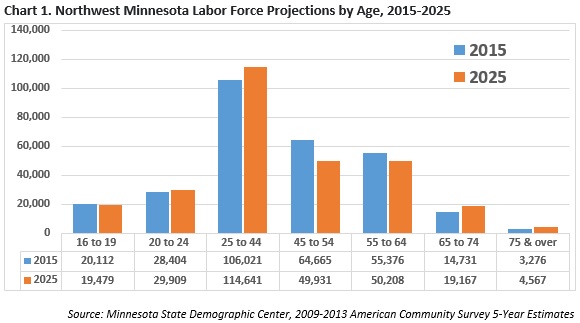 The presence of such industry powerhouses as Polaris, Arctic Cat and New Flyer make Northwest Minnesota a hub of transportation equipment manufacturing.
The presence of such industry powerhouses as Polaris, Arctic Cat and New Flyer make Northwest Minnesota a hub of transportation equipment manufacturing.
From wheat and potatoes to soybeans and sugar beets, the region is a major producer and processor of food staples and specialty agricultural products.
Want the freshest data delivered by email? Subscribe to our regional newsletters.
1/29/2016 12:13:02 PM
Chet Bodin
Throughout 2015, unemployment rates in Northwest Minnesota returned to low levels reminiscent of the 1990s, while employers reported a record number of job vacancies. This has created a tight labor market, which is only projected to get tighter in the future. By 2025, the labor force is projected to add approximately 9,500 workers between the ages of 16 and 44, but lose 14,175 workers aged 45 years and older (Chart 1).

Overall, the region is projected to lose about 4,700 workers total. It’s likely that the pace which younger workers and millennials will attempt to fill the void left by baby boomers will increase through that time. But what will be missed are the years of experience, vast connections, and leadership traits of the baby boom workforce exiters.
These assets won't be easy to replace. By numbers alone, it will be nearly impossible. Greater Minnesota Rising (GMR) set out to qualitatively rethink the workforce environment that regional industries, organizations and communities will operate in, and learn how they can adapt. The GMR qualitative research project was funded by the West Central Initiative and the Initiative Foundation in Little Falls to address these changes, and won a research grant from the Mary Page University-Community Partnership in summer 2015. More on the research questions and other project information appears in December’s Local Look blog post.
The magnitude of the growing influence of millennials in every facet of the economy can’t be overstated, and employers would be wise to take notice. Unlike previous generations, demand for available workers will increase, which may make these job seekers’ work and life preferences of pivotal interest. But the generational shift will also challenge industries’ ability to keep up with the times. Not only will employers need to attract and retain a new workforce; the makeup of a firm’s workforce will largely determine its outlook, innovation, and cultural purview. In other words, life experience in millennial culture may be as valuable as years in the workforce in general.
From that premise, the GMR research evolved in unexpected ways. Originally, the research proposed to learn more about young professionals in northwestern Minnesota and how those in the millennial generation might step into leadership roles. However, it quickly became clear the leadership required is not only of the millennial variety. Through academic literature, focus groups, and interviews with local hiring managers and other stakeholders, GMR found there are many engaged and talented young professionals in the region. So attracting and retaining emerging leaders was a more comprehensive, qualitative, and appropriate subject.
The GMR research indicated that an emerging leader possesses leadership potential but is ‘untested’ or lacks the years of experience that a ‘seasoned’ veteran might have. In addition, focus groups highlighted several other key factors:
Interestingly, emerging leaders are defined more by their circumstances than their age. The strong, persistent leadership exercised for by baby boomers has often kept potential Gen X leaders on the sidelines, and they're prepared to play a significant role with millennials in the workforce transition. This is good news for several reasons. The retention of Gen X workers addresses the gap in experience plaguing their millennial colleagues, and they have knowledge of and connections among both younger and older generations. In other words, their leadership may transcend the often negative perceptions millennials and baby boomers have of each other’s work habits, values, and approaches to technology.
In mid-December, GMR hosted a World Café in Fergus Falls with 30 participants from over 100 square miles. The goal was to develop recommendations for communities to engage and connect emerging leaders in northwestern Minnesota. The principles that emerged speak to what emerging leaders’ value when deciding on a place to live and work:
Local communities and employers from across West Central Minnesota appeared ready to work together and rebuild/market the life-work balance that millennials value. If they are to draw new workers wholesale, rural communities can ill-afford to approach regional challenges on their own for much longer. By working together, they can offer a diverse and collaborative atmosphere that emerging leaders thrive in and millennials expect.
If you are interested in learning more or helping to support Greater Minnesota Rising’s work, please visit their website and/or contact our leadership team.
Contact Chet Bodin.